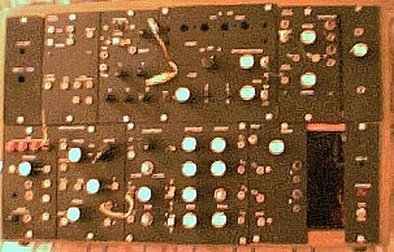My First Synthcirca 1973 -- says so right there at the bottom of the schematic.This was partly based on a project by Ralph Burhans and I included ideas from Don Lancaster's R.T.L. Cookbook and other circuits I got from here and there.

The VCO was a simple multivibrator. When the frequency control voltage from the resistor-string keyboard was removed, that is, when a pressed key was released, oscillation stopped. There was no CV sample and hold. The VCO output could be pulsed on and off. A capacitor to ground between 2 inverters 'stretched' the oscillator's square-waves into a Gate signal that would last as long as a key was depressed. The Gate could be pulsed, as well. VCO out went to a string of divide-by-2s so I could mix different octaves of square-wave in variable amounts to get different waveforms. The first divider could be pulsed to a 'pass' mode that did not divide, causing an octave-up warble. There was also a divide-by-5, 6 or 7 for more 'enrichment.' The 'Modulator' was an LFO multivibrator, with "sawtooth" and divide-by-2 or 4. Mr. Burhan's VCA included a simple diode-capacitor VCF. I also included passive filtering with circuits based on electronic organ 'stops.' Having no idea what the inductance might be, I used a winding of a small audio transformer as an inductor in one of the Stops. I changed Burhan's Envelope Generators so that I could get 4 E.G.s from one R.T.L. hex inverter. The pots labeled Sustain should actually be called Duration, as each E.G. was a one-shot. Notes would last only as long as the 'Sustain' setting, no matter how long a key was held down. I made one of the envelopes 'reversable': that is, the one-shot output could be inverted, so that the envelope fall occurred at the pulse start, and rise at the pulse end. For a keyboard, I contacted the Schober Organ Company, which was located just a subway ride away. I pestered who I thought was a sales rep, but who was actually the late Richard Dorf, head of the company, into selling me a manual (keyboard,) from one of their models. My first Pratt and Read single-bus keyboard. I was disappointed to see it was only 32 keys, F-C, instead of the 37 keys I expected. But it worked out well. I later used that keyboard for a digital design using priority encoders. Mr. Dorf had asked me to let him know how my instrument worked out. I sent him a cassette but never heard back from him. I guess my music wasn't his cup of tea. Can't say I blame him. Status: Disassembled and canabalized |